|
|
Small rivers project Our local research Special geographic features of the river location in the landscape of the city. Kova river passes through the high, mountainous part of the city, which is limited by Oka river from the West and from the North and East by the high manks of the Volga river. The central part of Oka and Volga highland interriverine space is occupied by the basin of Kova river. The valley of Kova river deeply cuts into area of the high part of Nizhny Novgorod and devides it into two parts the Western and the Eastern. Kova river takes source in a place located two km from our club. It starts from a spring. The river flows almost meridianally through the Eastern part of Sovetski district to empty into Rakhma river 1 km upstream of Rzhavka river. Kova is 11 km long. Its catchment area is 41 km2. The river passes through the district of private individual houses and then through the zone filled with apartement buildings. After the city the river enters the country side and proceeds among gardens, fields and orchards. 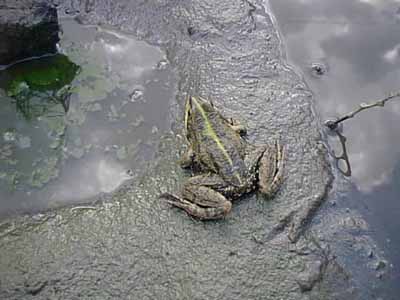
The basin of Kova river is cut by ravines. At the bottoms of those ravines the creeks flow. These are tributaries to Kova. The ravines, forming the valley of Kova river on the right are very long, up to 4 km and have high banks. The river is very polluted, the banks ate the dumping sites, the bottom is very swampy with a lot of sludge and garbage on it. Along the river, on the right the trees grow: willow, elm, poplar and maple. The width of the river and its depth increase in the autumn, when the melted snow waters flow from top down into the river the water level increases by 1-2 m. 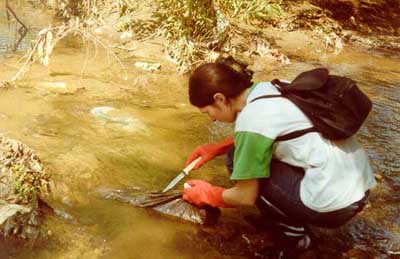
In the contemporary world the issue of polluted rivers and lakes occupies a special place, because these are sources of clean fresh water which are critical for the survival of man. The most heated this issue is in cities and towns, where the water reservoirs have esthetic and recreational value and which are subjected to huge recreational and industrial load: they take the household waste and the discharges from the nearby highways. As a result originally clean water reservoirs are converted into the gutters. To fight against such transformation it is necessary to carry out environmental monitoring of the condition and quality of water, besides it is necessary to conduct wide awareness raising campaign among the population of cities and other populated areas and regularly inform the population on the condition of rivers and lakes in the city limits. The anthropogenic pressure is registered in all the components of the water systems, first of all in the composition and ratio of numbers of various species of plants and animals living in the water and on the bottom. Many organizms met in the water reservoirs are good indicators of the habitat conditions, because for own development they need very specific values of ecolocical factors. Knowing the composition and quantitative dynamics of such indicator species it is possible to evaluate the quality of water in the water reservoir and ecological condition by their availability and quantitative developments. 
For the purpose of evaluation of the water quality and ecological condition of water reservoirs of various types (rivers and lakes) both urban and rural, which are less disturbed by man three water objects were studied: two lakes and one small river. They are Meschrskoye lake Kova river which are located in the limits of Nizhny Novgorod and Krugloye lake located at the territory of Kerzhenski nature reserve, which is almost free from the human pressure. The lakes have small water surface area and water volumes, that is why they are very vulnerable and subject to human impact and reflect very well the local conditions of formation of surface discharge from small areas. The length of Kova river is 11 km. Its 4 km is located in the limits of Nizhny Novgorod. Studying of phytoplankton (microscopic algae) Among all the ecological groups which are developing in the water reservoirs special place is given to the communities of microscopic water plants, which develop in the water phytoplankton and to the developing on the bottom phytobenthos. These organisms perform the same role, as higher plants on land. They are producers of organic matter, emit oxygen during photosynthesis and in case of excessive develpment cause blooming of water and worsening of quality. The composition of phytoplankton and phytobenthos includes many species of algae, which are biological indicators of a content of organic matter in water, for example (saprobicity). 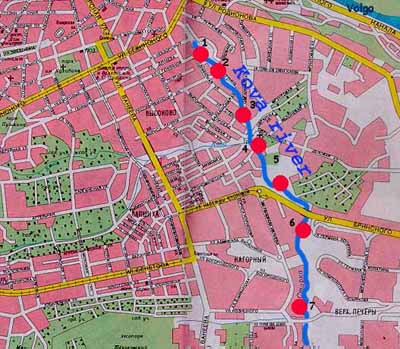
Thus due to the fact, that the plankton and benthos communities are structurally and functionally the compoments of water systems which are the first to react to the change in the habitat condition and which directly determine the physical and chemical properties of water masses the changes in them present one of the major aspects of water reservoir monitoring. In relation to this the aim of this research is the analysis of the composition and quantity of the algae in two small lakes and one river located at the areas characterized by differing levels of human impact, as well, as evaluation of their ecological condition and water quality by the indicator species of phytoplankton and phytobenthos. 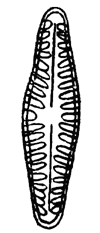
As a result of the study of the algae in the plankton and benthos in the water objects under study determined have been 99 species from 9 departments. The basis of the species diversity is formed by the diatomaceous (36 species; 36,4%) and green (33 species; 33.3%) algae. Significantly smaller diversity was registered with the green blue algae (8 species; 8.1%), euglen (7 species; 7.1%), yellow green (6 species; 6.1%) and dynophytous (5 species; 5.1%). The zhelto-zelenye, cryptophytous and raphidophytous algae are represented by 1-2 species. Out of 32 species available in Kova river 16 are indicators of saprobic condition. The major part of them (44%) are the indicators of b-a-mezo (31%) and a-b-mezosaprobic (13%) zones of organic pollution of water. Out of them the dominating specie is Navicula cryptocephala (64%). Out of oligsaprobic species we registered Meridon. circulare and out of a-mezosaprobic Euglena polymorpha. 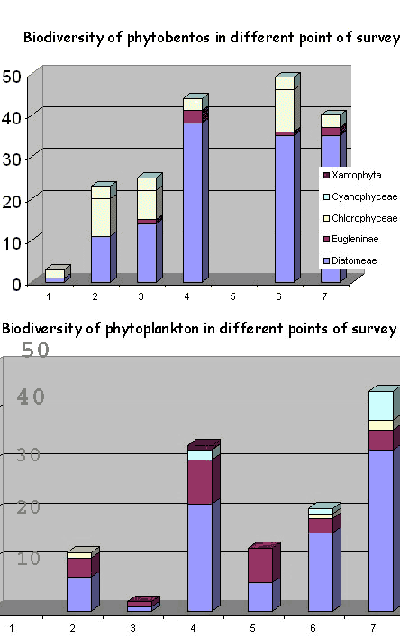
Due to the fact, that the dominating species forming the major mass of phytoplankton belong to b-mezocaprobic zone, and phytobenthos to b-a-mezo and a-b-mezosaprobic zone Kova river in general could be characterized, as an water object with elevated level of pollution by organic matter. The purity of small rivers and the amount of water in them are critical factors which influence the provision of the population and economy with water and the productivity of landscapes in the basins. It means, that the efficient use of small rivers (including Kova river) has major environmental and economic significance. The protection of rivers against pollution should be done in the course of their use. To our opinion the most important factor, which supports the need of the protection of Kova river is the fact, that the river stars from underground springs and is supplied with fresh water by the springs along all the route of the river.
|
|||
